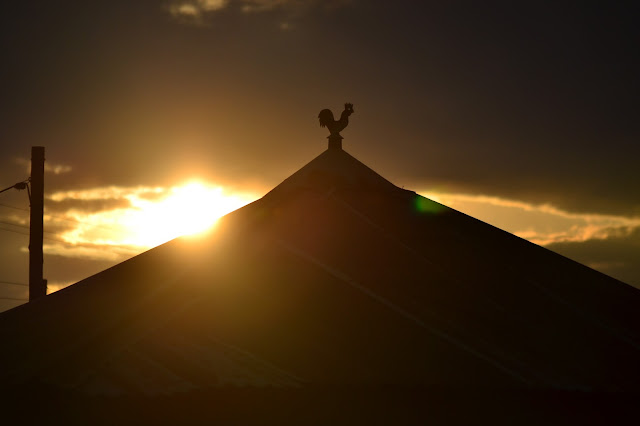Ah! Lwaganda. Ngqika, King Of The Rharhabe [1776-1829]
Another early start to the day on the morning of the 5th day of July 2015; destination:King Ngqika's grave.
Ngqika was buried at sunset on the day he died, according to full Xhosa custom inside a cattle kraal, in which oxen and cows were placed at night.
Their milling about obliterated the grave itself, in which Ngqika's karosses, clothes, ornaments, tobacco sack, pipe saddle and bridle, and the mats on which he had slept were laid beside him.
His assegais were broken and also placed in the grave.
All his huts and those of his wives were sealed and set on fire. All of his people, male and female alike, took off their ornaments and shaved their heads, and left the Great Place for a period of mourning in the bush.
A watchman of the grave was appointed, He had sole charge of the cattle in the funeral kraal, and milked the cows for his food.
He remained for a year, when the cattle were removed, but these beasts were sanctified and were to be killed or eaten; the watchman himself was a privileged person who thereafter could claim food from anyone; to affront or injure him was a grave offence, as if to the deceased chief himself.
Above text from "Frontiers : The Epic of South Africa's Creation and The Tragedy Of The Xhosa People" by Noël Mostert
"Ingcwaba Lo Kumkani" by S.E.K. Mqhayi
Published in Izwi Labantu, October 27, 1908
 iXesi (umlambo) lipuma kwi ntaba zakwa Matole, kwanje nge
iXesi (umlambo) lipuma kwi ntaba zakwa Matole, kwanje nge
Tyume (umlambo) liye ku ngena elwandle ngobutshantshatela
Obukulu kwele Ntlalo pakati ko Gompo no Cihoshe.
Ngumlambokazi odume kunene ebalini lama Xosa.
Kulapo zikona izigqubo,
Kulapo ikon’ imikondo,
Kulapo zikon’ iziganeko,
Igazi lisahleii nanamhla.
Ngumlambo omanzi amnandi,
Ngumlambo omanz’ anamandla,
Indonga zizele kucuma;
"No Ngqika usalele khona."
After paying my respects to the King, as the ancient Nguni custom would dictate, I added my stone on isivivane
Isivivane is a cairn of small stones that marks the warrior(s) grave site.
Ngqika was buried at sunset on the day he died, according to full Xhosa custom inside a cattle kraal, in which oxen and cows were placed at night.
Their milling about obliterated the grave itself, in which Ngqika's karosses, clothes, ornaments, tobacco sack, pipe saddle and bridle, and the mats on which he had slept were laid beside him.
His assegais were broken and also placed in the grave.
All his huts and those of his wives were sealed and set on fire. All of his people, male and female alike, took off their ornaments and shaved their heads, and left the Great Place for a period of mourning in the bush.
 |
| The King's Resting Place |
A watchman of the grave was appointed, He had sole charge of the cattle in the funeral kraal, and milked the cows for his food.
He remained for a year, when the cattle were removed, but these beasts were sanctified and were to be killed or eaten; the watchman himself was a privileged person who thereafter could claim food from anyone; to affront or injure him was a grave offence, as if to the deceased chief himself.
Above text from "Frontiers : The Epic of South Africa's Creation and The Tragedy Of The Xhosa People" by Noël Mostert
"Ingcwaba Lo Kumkani" by S.E.K. Mqhayi
Published in Izwi Labantu, October 27, 1908
 iXesi (umlambo) lipuma kwi ntaba zakwa Matole, kwanje nge
iXesi (umlambo) lipuma kwi ntaba zakwa Matole, kwanje ngeTyume (umlambo) liye ku ngena elwandle ngobutshantshatela
Obukulu kwele Ntlalo pakati ko Gompo no Cihoshe.
Ngumlambokazi odume kunene ebalini lama Xosa.
Kulapo zikona izigqubo,
Kulapo ikon’ imikondo,
Kulapo zikon’ iziganeko,
Igazi lisahleii nanamhla.
Ngumlambo omanzi amnandi,
Ngumlambo omanz’ anamandla,
Indonga zizele kucuma;
"No Ngqika usalele khona."
 |
| Isivivane |
After paying my respects to the King, as the ancient Nguni custom would dictate, I added my stone on isivivane
Isivivane is a cairn of small stones that marks the warrior(s) grave site.






u Sotsulubembe madoda, uHlek'abeneligqo
ReplyDeleteumPhambani nengcuka zigoduka,
iNtsimangwana yakwa nkwebu,
iNyoka emnyama ecanda iziziba.
ngu Xhalangalimaphiko amdaka,
uNtloyiy' onendlwane wase majojweni.
ngu Khala alinameva kodwa bathi liyahlaba,
Lirhamncwa elidla umzi liwukhanyela - Lithi udliwa ngu Nyelezi noo makhababhekile.
Ahh Lwaganda, inkunzi ka Mlawu.
Ngu Mvalo ovalela inkomo zika Phalo - oyowuvula ngoyakuzeka ityala.
Yinto elima beyisusa inga umhlaba ayingowayo.
ngu Vumba ligxotha izizwe,
Phuma entangeni wabe iinkomo wena ka Mlawu,
ubu mlala nje unyoko u Thuthula - ubusithi woyiva phi na imbathu kwedini?
Ahh Lwaganda!!